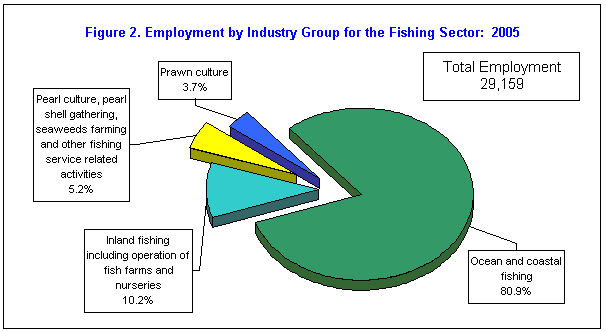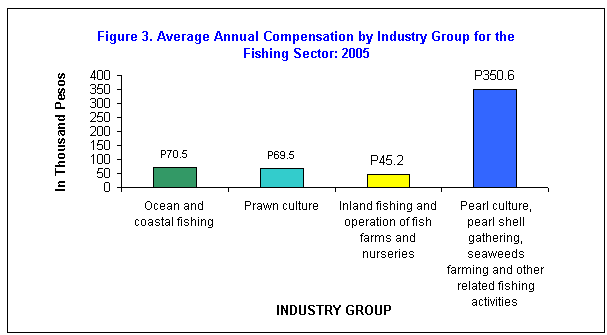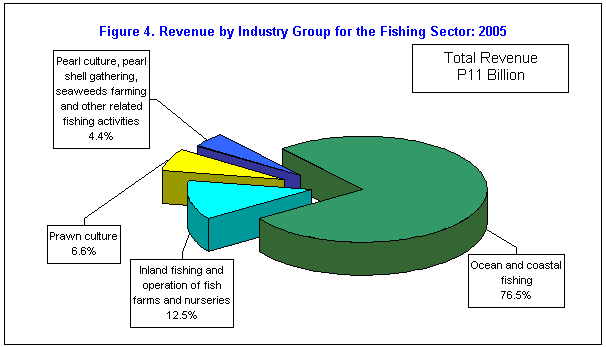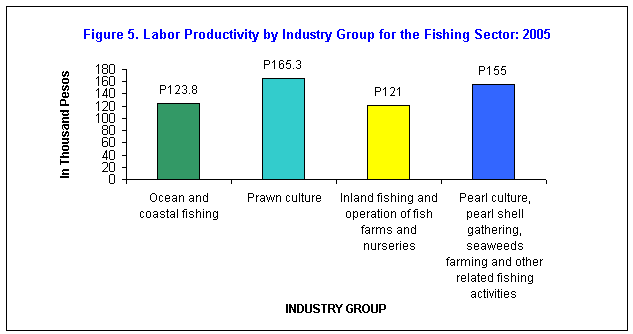Ocean and Coastal Fishing Industry Dominates the Fishing Sector
· There were a total of 1,052 fishing establishments in operation all over the country according to the 2005 Annual Survey of Philippine Business and Industry (ASPBI). Majority of this number (86.8%) were accounted by fishing establishments with average total employment (ATE) of less than 20 workers while the remaining 13.2 percent comprised fishing establishments with ATE of 20 and more workers.
· Ocean and coastal fishing industry dominated the sector with establishments count of 544 or 51.7 percent of the total. This was followed by inland fishing and the operation of fish farms and nurseries (32.0%) and pearl culture, pearl shell gathering, seaweed farming and other fishing service related activities (9.2%). The least number were establishments engaged in prawn culture (7.0%). Figure 1 shows the distribution of establishments by industry group for the fishing sector.

Ocean and Coastal Fishing Industry Generates the Biggest Number of Workers
· In 2005, total employment of the sector was estimated at 29,159. Fishing establishments with ATE of 20 and more workers employed the biggest number of workers estimated at 20,029 representing about 68.7 percent of total employment for the sector.
· By industry, ocean and coastal fishing employed the biggest number of workers at 23,587, which is equivalent to 80.9 percent of total employment for the sector. Figure 2 shows the distribution of employment by industry group for the fishing sector.

Average Annual Pay is P82.0 Thousand per Fishery Worker
· Total compensation paid during the year 2005 amounted to P2.2 billion, indicating an average annual compensation of P81,996 per paid fishery worker.
· Among industries, average annual pay was highest at P350,586 for workers in pearl culture, shell gathering, seaweeds farming and other fishing service related activities while it was lowest at P45,153 for inland fishing and the operation of fish farms and nurseries. Figure 3 compares the average annual compensation by industry group for the fishing sector.

Ocean and Coastal Fishing Industry Generates P8.4 Billion in Revenue
· Revenue generated by the sector in 2005 was estimated at P11 billion. Industry comparison showed that ocean and coastal fishing earned the biggest revenue for the sector amounting to P8.4 billion or 76.5 percent to total revenue. Figure 4 displays the revenue shares by industry group for the fishing sector in 2005.

Prawn Culture Industry Achieves Highest Labor Productivity
· Labor productivity for the sector, measured as the ratio of value added per total employment, was estimated at P126,698 in 2005.
· The prawn culture industry achieved the highest labor productivity amounting to P165,263 while inland fishing and the operation of fish farms and nurseries recorded the lowest at P121,002.

TECHNICAL NOTES
The 2005 Annual Survey of Philippine Business and Industry (ASPBI) is a continuing activity of the National Statistics Office aimed at collecting information on the structure and levels of economic activities in the country. It is the 38th in the series of annual surveys of establishments conducted by the Office and the 14th in the series for the fishing sector.
The survey is undertaken by authority of five (5) legislative acts and presidential directives namely: Commonwealth Act No.591, Presidential Decree No. 418, Executive Order No. 121, Executive Order No. 352 and Executive Order No. 5.
The reference year of the survey is 2005.
Scope and Coverage
The unit of enumeration of the survey is the establishment. It is defined as an economic unit under a single ownership or control, engaged in one or predominantly one kind of economic activity at a single fixed location. Establishments are classified according to economic sectors, which are the scope of the survey. Fourteen sectors of the Philippine economy are covered in the 2005 ASPBI.
One of these sectors is fishing. It is comprised of nine (9) industry groups, namely:
- ocean and coastal fishing
- inland fishing
- prawn culture
- operation of fish farms and nurseries
- mollusks and other crustacean farm operations (except prawn farm operations)
- pearl culture and pearl shell gathering
- seaweeds farming
- service activities incidental to fishing
- fishing activities, n.e.c.
Sampling Design
Stratified systematic sampling was utilized to select samples for the 2005 ASPBI. The updated 2004 List of Establishments (LE) was the frame used to draw the sample establishments
Employment size, defined as the average total employment (ATE) of an establishment, served as the stratification variable. The domains were region and industry for the group of establishments with ATE of 20 and more. For establishments with ATE of less than 20, the whole country and industry served as the domains.
The amended 1994 Philippine Standard Industrial Classification (PSIC) was used to classify establishments according to economic activity from which they derive their major income or revenue. On the other hand, geographic locations were classified according to the Philippine Standard Geographic Classification (PSGC).
Response Rate
Questionnaires were distributed to sample establishments starting on April 3 to April 28, 2006. The respondents were generally given 30 days within which to accomplish the questionnaires. Collection of accomplished questionnaires from respondents was programmed from May 2, 2006 until August 31, 2006. Manual and machine processing, and tabulation of data were undertaken at the Central Office.
The effective response rate is 51.8 percent for the fishing sector. For establishments with ATE of 20 and more workers, the effective response rate is 53.8 percent while that for establishments with ATE of less than 20 workers is 51.8 percent.
Concepts and Definition of terms
Establishments - An economic unit under single ownership or control, i.e., under a single legal entity, engaged in one or predominantly one kind of economic activity at a single fixed location, and having permanency of assets in its premises during the operation. It is also defined as the unit that is engaged in the production of the most homogenous group of goods and services, usually at one location, but sometimes over a wider area, for which separate records are available that can provide data concerning the production of these goods and services and the materials, labor and physical resources used in this production.
Fishing Establishments - A farm or company engaged in ocean, coastal and inland fishing; fish farms, fishpond, fishpen; pearl farms and other fishery activities.
Economic activity or business - is the activity of the establishment as classified under the amended 1994 Philippine Standard Industrial Classification (PSIC). Generally, the main activity of the establishment is the establishments principal source of income. If the establishment is engaged in several activities, its main activity is that which earns the biggest income or revenue.
Average total employment (ATE) - is the sum of the number of persons who worked in or for the establishment for all months of the year divided by 12, regardless of the number of months the establishment is in operation.
Total Employment - includes all persons who worked in or for the establishment as of the period November 15, 2005.
Paid employees - include all persons working in the establishment and receiving pay, as well as those working away from the establishment paid by and under the control of the establishment. Included are all employees on sick leave, paid vacation or holiday. Excluded are consultants, home workers, workers receiving pure commissions only and workers on indefinite leave.
Working owners - are owners who are actively engaged in the management but do not receive regular pay, i.e., not included in the payrolls. Managers and directors of corporations working for pay are reported as managers.
Unpaid workers - are persons working for at least one-third of the working time normal to establishment and do not receive regular pay. Included are working owners who do not receive regular pay, apprentices and learners without regular pay.
Salaries and wages - are payments in cash and in kind to all employees, prior to deductions of employees contribution to SSS/GSIS, withholding tax, etc. Included are total basic pay, overtime and other benefits.
Employer's Contribution to SSS/GSIS and the like - refers to payments made by the establishment for social security in behalf of the employees. Examples are SSS, GSIS, PhilHealth and PAG-IBIG.
Revenue - refers to cash received and receivables for goods sold and services rendered. Valuation is in producers price (ex-establishment), net of discounts and allowances, including duties and taxes, and excluding subsidies.
Cost - refers to all expenses incurred during the year whether paid or payable. Valuation is at market price including taxes and other charges, net of rebates, returns and allowances. Included are goods and services received by the establishment from other establishments of the same enterprise and valued as though purchased.
Subsidies - are special grants in the form of financial assistance or tax exemption or tax privilege given by the government to aid and develop an industry or production process and to protect it against competition. Included are tax audit, tax and duty exemptions, price support and price discount, and interest rate subsidy.
Fixed assets - are physical assets expected to have productive lives of more than one year and intended for use and/or being used by the establishment. Included are land, buildings, other structures and land improvements, transport equipment, computers and peripherals, telecommunications equipment and apparatus, other machinery and equipment including furniture and fixtures, and cultivated assets.
Gross additions to fixed assets - is equal to capital expenditures less sale of fixed assets, including land.
Inventories - refer to the stock of goods owned by and under the control of the establishment as of fixed date, regardless of where the stocks are located. Valuation is at current replacement cost in purchasers prices. Replacement cost is the cost of an item in terms of its present price rather than its original cost.
Finished products inventory - refers to the goods made by the establishment, which are ready for sale/shipment as of reference date. Valuation is at producers price.
Work-in-progress inventory - refers to the value of all goods which have been partially processed by the establishment but which are not usually sold or turned over to other establishment without further processing. Valuation is at producers price.
Change in inventories - is the total value of ending inventory less the total beginning inventory.
Census value added - represents the difference between the value of output and the total costs of materials and supplies consumed, fuels purchased, industrial services done by others and goods purchased for resale.
Value added - reprerepresents the sum of census value added and value of non-industrial services done for others less the cost of non-industrial services done for others and other costs.
Detailed Statistical Tables
Detailed tables at the national and regional levels are available upon request from the Industry Statistics Division, National Statistics Office, 4th Floor, Solicarel Bldg II, Ramon Magsaysay Blvd, Sta Mesa, Manila Tel No. (062) 716-39-32.
Source: National Statistics Office
Manila, Philippines
